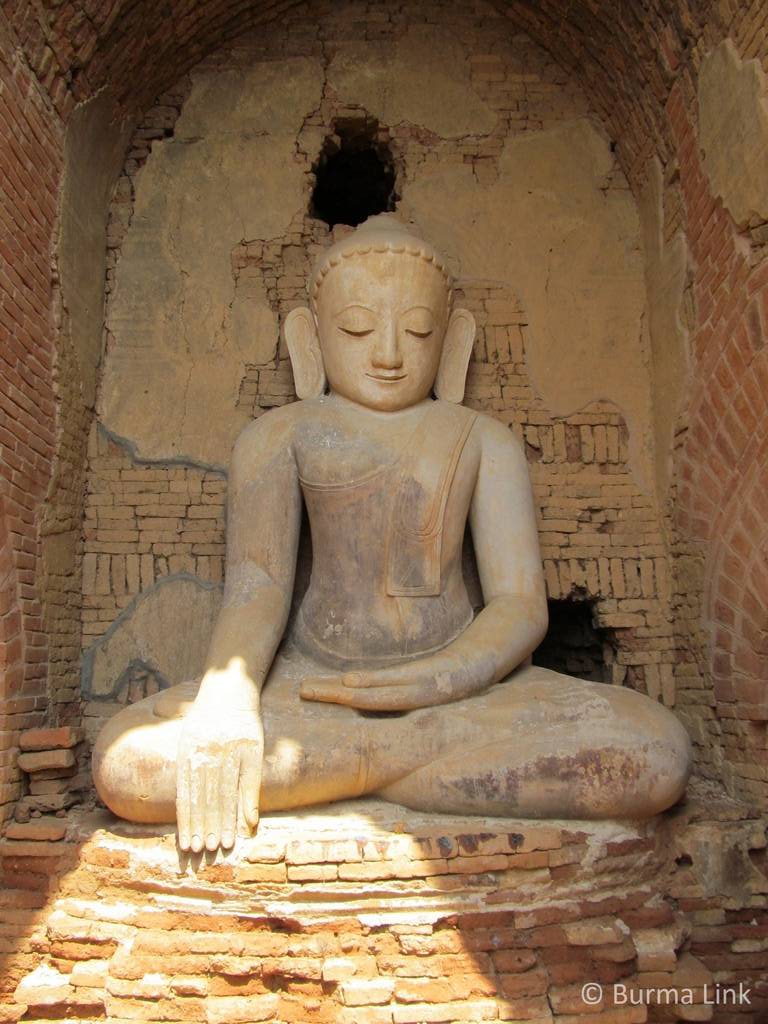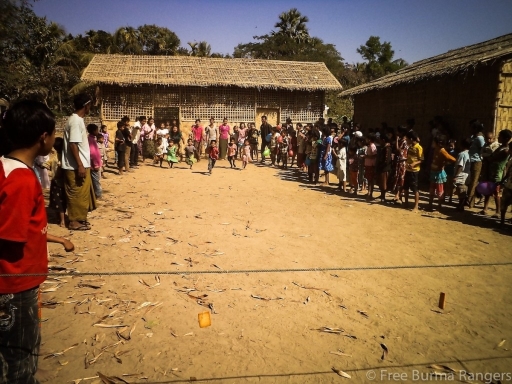As the Rohingya currently reside in the Arakan State their situation is also discussed below without any reference as to the legitimacy of their indigenous status.
There are many subgroups of Arakanese, including the Mro, Thet, and Khmi. While all the groups speak Arakanese, many subgroups of dialects make communication between different ethnic sub-groups difficult. As a result of the government policy of Burmanisation, many Arakanese are also unable to read or write their own language. Arakanese language is mainly taught at the Arakanese Buddhist monasteries in the Arakan State and is also used by exiled political organisations (Thein Lwin, 2011). Many Arakanese feel that not only the language but Arakanese history is also getting lost. It is not taught in schools and there are no reference books documenting the history (Centre for Peace and Conflict Studies, 2010).
Arakanese identity is usually strongly bound with Buddhism and vast majority of Arakanese are Buddhists, although some Christian communities are also found in the state. While the Arakanese share many holidays with other Buddhist groups in Burma, considerable differences exist in the ways in which these holidays are celebrated. The state is also home to most of Burma’s Muslims, some of whom also live in urban areas of lower Burma. Muslims in the northern Arakan State are generally known as Rohingya while other Muslims in the Arakan State are referred to as Arakanese Muslims. Arakanese Buddhists and Muslims speak the same language. The Rohingya language is similar to the Chittagonian dialect spoken in Bangladesh (Ekeh & Smith, 2007).
Although there have been Muslims in Arakan State for hundreds of years, Arakanese and Burmese have often not welcomed them. A group of Muslims called the Rohingya have been targets of a particularly hostile behaviour and neither Arakanese nor other ethnic groups in Burma recognise them as an indigenous ethnic group belonging to the country. Rohingya leaders rebelled against the government already in the 1940s and then again in the 1960s when they formed the armed Rohingya Independence Force (RIF), which later broke into separate organisations (ARNO, 2006).
Arakanese also have a troublesome history with the majority Burman; the state was first conquered by the Burmese military in 1784 and armed insurgency lasted until the British annexation of the state in 1826 (Smith, 1994). Before Burma gained independence, some Arakanese nationalists supported the British, while others such as the Arakanese National Congress (ANC), including Muslim Arakanese, supported the AFPFL. Some Muslims wanted to create a Muslim State in northern Arakan State, causing tensions between the Buddhists and Muslims as well as a split in the national movement. Burmese Muslims in the Arakan State, who are not Rohingya, have also set up several opposition groups, such as the Muslim Liberation Organisation of Burma (MLOB) and All Burma Muslim Union (ABMU) (see Rianne Ten Veen, 2005).
The Arakan State is rich in natural resources such as seafood, natural gas, and timber, but they rarely benefit the local people. On the contrary, resource extraction has resulted in widespread environmental degradation. Lack of infrastructure, access to education, and gender issues are other sources of grievances for all groups (Centre for Peace and Conflict Studies, 2010).
Human rights violations such as land and property confiscations, forced labour and forced relocation, open discrimination and violence against ethnic nationalities and women, and lack of access to arable land, as well as tight controls of local economies continue to create serious problems of poverty and food insecurity (AHRDO, 2011a). The development of essential services such as education and health care has largely been neglected in the state, poverty and illiteracy are widespread, and many children do not attend school due to poverty (AHRDO, 2011b).
Ethnic grievance and tensions with the central government have continued until the present day. Arakanese report widespread human rights violations including rape, forced labour, and portering. Arakanese people report that the military has a ‘license to rape’ and a mandate to mate’ (Centre for Peace and Conflict Studies, 2010, p. 304). Arakanese also feel that the government is systematically destroying their ethnic culture through practices such as forced pregnancy and inter-ethnic marriage.
While some Arakanese people have lost hope for the international community to help them, others wish the international community to aid them in capacity development and raising awareness (Centre for Peace and Conflict Studies, 2010). Armed resistance has recently grown in popularity as the government has become more repressive in the Arakan State. The state is also increasingly militarised (AHRDO, 2011a).
Many Arakanese feel that their relationships with other ethnic groups than the Burman and the Rohingya are good (Centre for Peace and Conflict Studies, 2010). The Burman are viewed as being the same as the Burmese military, and the Rohingya are not accepted as an indigenous ethnic group. The Rohingya are looked down upon, and considerable tension exists between the two groups. According to the Arakanese, Rohingya immigrated to the state illegally from Bengal during the colonial times. Arakanese also feel that Rohingya receive preferential treatment from the international community as they are given more international assistance (Centre for Peace and Conflict Studies, 2010). This perception seems largely accurate and the international community has not only neglected the Arakanese plight but also effectively silenced Arakanese voices regarding the problematic issue of Rohingya in the state.
Nevertheless, the Rohingya are oppressed and discriminated against people who are rendered stateless in Burma, and equally oppressed in the refugee camps in Bangladesh. In 1978, 200,000 Rohingya fled to Bangladesh followed by another 250,000 in the early 1990s (Head, February, 2009). The UN-supervised mass repatriations in the early 1990s forcibly returned over 200,000 mainly Rohingya refugees to Burma despite the continuation of gross human rights violations (Human Rights Watch, 1996).
“There was a general agreement that voluntary repatriation is the preferred and best solution to the refugee problem. However, it was noted that in some instances UNHCR has placed too much emphasis on early return to countries of origin which has resulted in return movements to less than favourable conditions”. (UNHCR, Oslo Declaration and Plan of Action, June 1994, as cited in Human Rights Watch, 1996).
ARNO (2012) reports that many refugees also lost their lives over the years whilst resisting forced repatriation. Rohingya refugees have since formed a number of protest movements to oppose forced repatriation unless conditions in northern Arakan State improve significantly. Today 30,000 people remain in the refugee camps in Bangladesh (UNHCR, 2012c), where they also find themselves unwanted and oppressed. Rohingya refugees have reported that in 2004 the local police shot three refugees and injured dozens of others in the refugee camps, which were also looted by local people, forcing large numbers of refugees to flee the camps (Thanakha Team, 2005).
While northern Arakan State is one of the poorest and most isolated in Burma, it has been argued that the burdens imposed on the Rohingya by the Burmese government make their situation even worse than other people living in the area (Head, February, 2009). UNHCR assists some 800,000 Muslim residents in the Arakan State who do not have citizenship. Another 200,000 live in Bangladesh as illegal immigrants, without rights to employment, health care or education (Dummett, February, 2010).
The dispute regarding the Rohingya and their right to Burmese citizenship is ongoing. The UN has described Rohingya as “one of the world’s most persecuted minorities” (AFP, June, 2012).They are not allowed citizenship in Burma or in Bangladesh, not allowed to travel without official permission, are banned from owning land and are required to get a permit to marry and sign a commitment to have no more than two children (Head, February, 2009). Citizenship restrictions on the Rohingya population have deepened their exclusion from employment and other opportunities, and the Burmese army continues with killings and rape as well as to impose forced labour on Rohingya villagers and children (ARNO, 2012). Even NDF has declared that they do not accept the Rohingya as an ethnic people of Burma (RFA, June, 2012), while the Rohingya claim that historically they belong to the state, as the area was ruled by Muslims from 1430 to 1531 (ARNO, 2012).
Communal violence broke out between Buddhist Arakanese and the Rohingya in June 2012 (AFP, June, 2012). Since then, and as many as 104,000 people have been displaced, all in desperate need of food, shelter, and medical care (Human Rights Watch, October, 2012). According to a damage assessment by Human Rights Watch in October 2012, there were at least 811 destroyed structures in the state as a result of the unrest. Approximately 75,000 IDPs remained in some 40 IDP camps in Arakan State in October 2012 (Human Rights Watch, October, 2012).
Despite dire conditions for Rohingya in Bangladesh, scores still flee across the Bangladesh-Burma border, and many have taken dangerous voyages by rackety boats towards Southeast Asian countries, causing hundreds of them drowned over the years (ARNO, 2012). There are still fresh reports of ongoing violence in Arakan State (e.g. OSAC, July, 2013). While there is much documentation on Rohingya escaping Arakan State in order to flee to Bangladesh or the sea, Arakanese claim that scores of Rohingya (or Bengali Muslims as Arakanese often call them) also keep crossing the border to Arakan State claiming that they have originated there (AHRDO, 2013).
The Rohingya issue and more generally the conflict between Muslims and Buddhists represents one of Burma’s most complex problems, essential to address and solve in order to achieve sustainable peace and reconciliation, and to help all people in Arakan State and elsewhere in Burma to live without fear and with equal rights dignity.
Updated October 17, 2014
Continue to Chin

